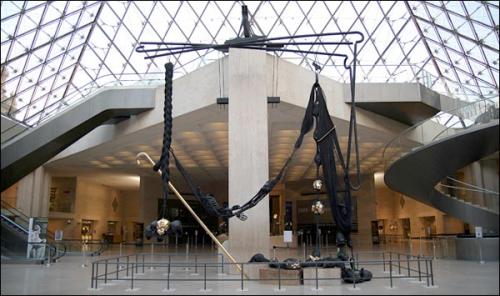Tunga
dal 27/9/2005 al 2/1/2006
Segnalato da
27/9/2005
Tunga
Musee du Louvre, Paris
Pei's pyramid hosts a monumental installation of a contemporary artist: Tunga

For the first time, the Louvre pyramid becomes an exhibition place displaying the monumental installation of a contemporary artist. Honouring its commitment to the work of living artists and on the occasion of the Year of Brazil in France, the Louvre has commissioned a piece by Brazilian artist Tunga, to serve as a strong and spectacular beacon radiating the creativity of contemporary Brazilian art, and to provide a counterpart to the exhibition Frans Post, Brazil at the court of Louis XIV. A Brazilian artist’s contemporary vision of the Louvre as a universe of creations and of the relations between the Old and New Worlds thus parallels a 17th century Dutch artist’s pictorial and documentary archive of Brazilian landscapes.
A major contemporary artist
Born in 1952, Tunga (Antonio José de Barros Carvalho e Mello Mourão) trained as an architect and is considered as one of Brazil’s major contemporary artists. In France, his works have been presented at the Galerie Nationale du Jeu de Paume in 1992 and in 2001. Exploring the intersection of performance, poetry, installation and sculpture, he uses fiction and myth to compose pieces whose freedom and exuberance often call to mind the Baroque era. This piece is a sculpture hanging from a crossbeam affixed to the central column of the space under the pyramid. With its elements suspended in the manner of marionettes, the installation creates the illusion of maintaining its own equilibrium. The “soft†elements hang from the joining of the three main iron rods: hammocks, braids, masses of hair, in which “hard†elements are trapped, such as skulls, or the heads of celebrated statues from the Museum’s collections.
Alchemy of the Word and of human work
Light floods the work through the glass pyramid with black and gold reflections. This assembling of metals is very close to the alchemical processes Tunga often refers to. This alchemy is as much one of the verb, as the traditional one of human work on minerals. We can see here, as we did in past works (Lizart, 1989), an analogy between the metallic energies and those of the human body. Indeed Tunga’s installations function according to a process of «mutual contagion» associating different types of identities, fixed or fluid, to ensure the flow of energy. A temporal analogy is drawn between what is left of our world, symbolised by the presence of famous heads from the museum, and the skulls suspended over them, that could be their reflection transformed by the mirror of art.
Look at the world in the light of the two worlds.
Tunga combines the past and the present in his work, as well as shade and light, the material and the spiritual. He brings together the two aspects of the Brazilian soul: on the one hand its prolific nature, the savage state, and on the other order and progress. Through his original creation, he invites us to reread in a critical manner the history of the relations between the colonizing countries and the former «new lands », by deconstructing the reassuring opposites and hierarchies regarding nature and culture, Europe and America, the fine-arts and crafts... What appears in front of the European model of the Enlightment is not the so-called savage obscurity of the New World; he now has us look at the world in the light of the two worlds.
Illustration: Tunga, By the light of the two worlds. © musée du Louvre/Angèle Dequier
Déléguée à la communication: Aggy Lerolle.
Attachée de presse: Laurence Roussel
This exhibition was made possible thanks to the generous support of Max Blumberg and Eduardo Araújo, American Friends of the Louvre. The installation was made possible with the assistance of Galerie Templon, Paris and Galeria Andre Millan, São Paulo
Musee du Louvre
75058 Paris cedex 01. Under the pyramide. Métro Palais-Royal
Hours: Open daily except Tuesdays from 9 am to 9.30 pm
Free admission.



